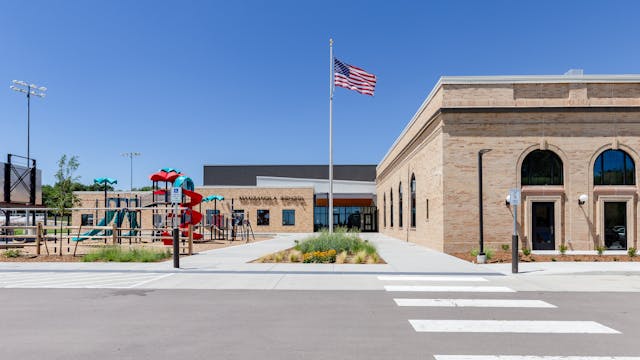Josh Grenier got a powerful lesson in the benefits of revitalization when he was a high school art teacher in Edina, Minnesota. He was teaching ceramics and photography in a dull classroom in the basement. No windows. Poor ventilation.
“It was an old, underutilized, leftover space down in the bowels of the building,” Grenier says.
Worse, the dreary room seemed to reflect an unspoken, but obvious, negativity directed at the people who used it: “I think the program and the students who were involved with it were not perceived particularly well.”
Within a few short years, though, the school went through a major renovation, which included a new, stylish fine-arts wing at the front of the existing structure. Grenier and his art students moved from “the worst space to the best space” in the building, a shift that transformed how others perceived the arts program, and how the students perceived themselves and their place in the school.

“Facilities investments are really expressions of what a community values,” Grenier says. “I think the people who are in them feel that; I witnessed that firsthand.”
The experience so moved Grenier that he left his nine-year teaching job to become an architect. Today, he’s an educational practice leader and educational planner in the Denver office of Wold Architects & Engineers, where he works with communities across Colorado that are trying to shape their school needs for the future. Sometimes they choose to build new schools. More often, they revamp old schools that have been around for decades, but lack the space or mechanical systems to meet the demands of modern learners.
Grenier and his design peers are part of a pivotal moment in education. Shifting populations have left cities and towns with unused school buildings in zero-growth areas and too few classrooms in high-growth areas. Many schools still in use were constructed in the boom years after World War II and don’t meet today’s building codes, some dangerously so. A 2020 report by the Government Accountability Office found that more than half of the nation’s 100,000 K-12 schools need to replace heating, ventilation and air conditioning systems or plumbing to mitigate health hazards.
At the same time, the amount districts have to spend on school renovations has dropped by about $85 billion a year nationwide since 2016, according to a recent report from the American Institute of Architects. This despite research of the past 20 years showing a strong link between unhealthy school buildings and poor learning outcomes. The Harvard School of Public Health concluded in 2017 that by failing to modernize old schools “policymakers and parents may be missing one of the largest health and safety issues affecting students daily.” On the other hand, the study’s authors wrote, “properly designed, maintained and operated school buildings…have been shown to prevent cognitive deficits, optimize student and teacher performance, and create a thriving learning environment within the school.”
In Colorado, about 85 percent of the population lives in urban areas; its small plains and mountain towns struggle to keep their identities. Grenier has worked with districts of all sizes in the state, including Manzanola School District, with fewer than 200 students; the eight-school district in touristy Cañon City, southeast of Aspen; and St. Vrain Valley Schools, the state’s seventh largest district.
Grenier spoke with EdSurge about the challenges of rebuilding old schools — and how his experience as a teacher informs every aspect of his job.
This interview has been edited for length and clarity.
EdSurge: When you talk about how depressing it was to work in a basement, I think many people would identify with that. There are thousands of offices and schools where only a select few have access to light.
Josh Grenier: You’re pointing to something that I was very conscious of. Spaces communicate something to us about where we sit in a hierarchy of the world and how we’re valued and perceived by others. Schools are very much that way, too.
In that [Edina] school, we had a front that was nice and well invested in, and it had a back with dumpsters and a loading dock. The buses dropped the kids off in the back by the dumpsters. The people who owned their own cars and could drive themselves to school would park in the front, and they’d walk in the nice front door. And I remember thinking, ‘what is that saying?’ If you don’t have a car and you’re of lesser means, well, you come in the back door by the dumpster. That’s the kind of thing that if you’re not thinking about it, the buildings themselves can communicate that.
Did that orientation change when the school was renovated?
No. That project was not perfect. That was another reason why I thought that I could contribute by joining the architecture side. We were winners — the arts program. But there were others who were not. There were other parts of the building that could have been thought about more deliberately.
What’s involved in designing for modern learners?
There’s so much variety from student to student of what they’re doing throughout the day, when things are happening, how things are unfolding. There are far more moments of independence, informal opportunities.
That’s another part I like about having been a teacher. I’m pretty good at imagining what’s going to happen, and I like doing that. You’re working on a floor plan, you’re working on a space, and you’re trying to just imagine, well, there’s that kid and there’s all those backpacks, and here he goes doing this, and there she is doing that. They’re gathering over here, and the teachers are walking from here to here, and they’re stopping here.
That’s always been something that I find a lot of pleasure in, just imagining what’s going to happen.
I had a teacher in architecture school who encouraged [us] to try to make it so that people feel they’re being embraced by this space. If you can’t find in yourself some fondness for whoever is going to be there, well, what are you doing?
Many kids today have conditions that hadn’t been identified when these old schools were built. How do you accommodate them?
It’s not a revolutionary idea, but allowing spaces to be used in a variety of different ways helps. You don’t have to make everything dedicated to one function.

Furniture is a huge part. It is the furniture that can help make those flexible spaces work. Things that are on wheels to support different uses or subtly separate one space from another.
You see a lot of modern furniture that has a ‘fidget component’ built into it so a kid can kind of vibrate. You know, a lot of times, kids just have extra energy; they’ll stay more engaged and more present if you just let them fidget.
It’s complicated and costly to renovate a school. How does it begin? In Cañon City, for instance, you took on four schools at once.
Mostly we just listen. People are pretty quick to talk about what’s wrong. We also try to lean into ‘what are you proud of? What are you really good at?’ We try to find a few things that they can rally around and then build a list of possible projects at each of the four schools.
One of the complexities of planning with large entities is that you’re trying to navigate lots of different individual stakeholders and everybody has their own unique point of view. You’re trying to help [them] see bigger picture things. But that’s another benefit of having been a teacher. I feel like [teachers are] pretty good at facilitating those kinds of conversations.
The featured project was the high school. Like so many of our public schools, it was built in the post-World War II era. Most schools start there. And then it’s been added onto, like, 10 times.
They become Franken-buildings…?
[Nods] They become mazes. The circulation becomes overly complex. They’re disorganized and confused. But that school, Cañon City High School, was really proud of its CTE programs. They’re a model in the state for allowing student choices to define the educational path that each of those students is going down. And they have a lot of specialized spaces already in place. But what they were lacking was a central part to the building that reinforced and supported all these piecemeal things that had been cobbled together.

We really focused on creating a new core to the building that felt like it reflected the pride they had in their programs.
How do emotions and nostalgia play into design? How did it work in Manzanola?
The town is around 400 people. In communities like that, the school really is the heart of the town. With those small communities, one of the first things we hear is that they’re afraid if the school goes away, the whole town will go away.
Athletics are huge, and it’s not just Friday night football. Members of the town and the outlying areas will attend athletic events even if they don’t have kids in the school system. In addition to athletics, performances are huge. [The school gym] is usually the biggest space in town. When a prominent member of the community passes away, they have the funeral in the gym. People get married in the school.
That alone makes it fun because it’s just such a key element to that community.
[We knew] it was going to be a public-facing building off-hours because of so much of the community use. It really needed a public side and a learning side with a pretty clear boundary.







